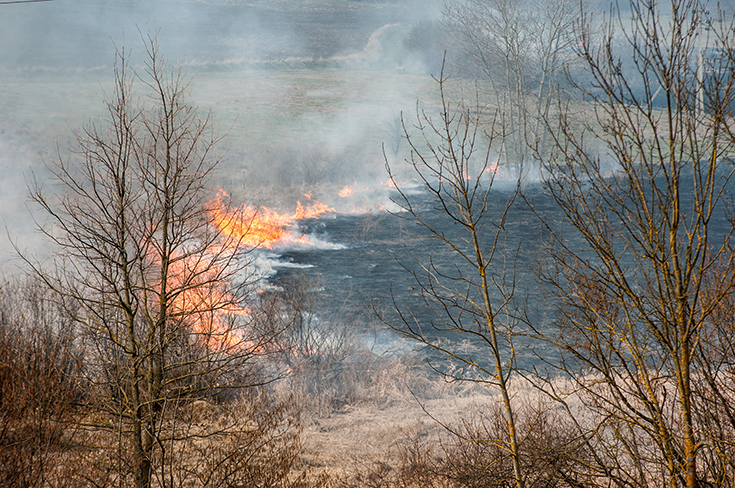Truth, trust and the ghosts of our fears: Chernobyl wildfires
Lina Kolesnikova examines why the recent wildfires near the Chernobyl nuclear reactor have led to old fears resurfacing.
There are different kinds of disasters. Sometimes, a disaster hits and then it is gone. But there are others – they hit and leave an open wound for a long time. The fear is etched in our memories and, one day, they shake us again. Nuclear disasters are among them.

The traditional burning of grass and rubbish on fields after the winter in many countries presents a headache for the emergency services, even more so in Ukraine, near the site of Chernobyl (Stock picture/Pavlo Bakhulkh/123rf)
Nuclear disasters are characterised by powerful mobilisation and all-in response. But a response is always time limited. When a new normality is eventually established, it accommodates the lasting effects of such disasters.
It is very difficult, however, to maintain focus and mobilisation over a long period of time as many other things happen and claim the attention of authorities and the society. But these ghosts chase us, even as we disregard how serious situation is or might become. And, one day, our worst fear may resurface, traumatising us all over again.
Some countries implement tough laws and decisions by authorities, but their application is not so strict. Deeds are often not as tough as the words, one could say. There are other countries where application of words is straighter and stricter. Owing to such differences between words and deeds, the former countries might suffer more because of a lack of confidence and trust in authorities. This might become critical during a crisis or during a situation that society might perceive as a crisis. Society’s resilience – its ability to stay reasonable and adequate – to a significant extent depends on trust between various groups of the population (elite and authorities included) which make up the society. Lack of trust undermines the ability of the society to be resilient.
In 2020 we see the return of places that have previously experienced nuclear disasters in the world news. In February, public debate was raised by the news that the Fukushima nuclear plant had released radioactive water from three damaged reactors into the Pacific Ocean. Despite the IAEA supporting this decision, it was very much opposed by environmentalists groups around the world, as well as Japan’s neighbouring countries (South Korea, for example).
From the beginning of April, Europe has become hugely concerned with wildfires in Ukraine. Why do you think Europe has such a profound concern? The answer is Chernobyl, the most disastrous peacetime nuclear disaster. Chernobyl drives our old fears. From April 4, fires have been burning across a large territory, including the 30-kilometre exclusion zone around the ghost nuclear plant and its radioactive waste site.
Spring fires, often caused by people trying to dispose of dry grass and rubbish on fields after the winter, present a headache for emergency response authorities in many countries. In Ukraine, strong wind provoked the rapid flame spread, which quickly reached the abandoned city of Pripyat. Weather conditions of the past winter – less snow, lowering groundwater levels, drained peatlands – contributed to the fire spread and complicated the fight against it. An additional factor that impeded the work of State Emergency Service employees, was the strong wind, which changed direction three times. The 18-kilometre background fire presents a further complication.
For ten days, Ukrainian emergency services have fought the blazes. The total number of personnel involved has reached 530 (other reports place the numbers at 723), 103 (154) special vehicles and two helicopters also formed part of the firefighting effort. Then a report came in saying they had managed to bring the fire under control. Emercom of Ukraine announced that the radioactive situation is also under control, the nuclear plant and radioactive waste sites are safe, and there is no danger to the safety of the Ukrainian population.
And the old ghost, fed by the lack of trust, has resurfaced. On April 16, Yaroslav Emelianenko, a local tour operator and social network whistle-blower, insisted that the fire is still burning and is not under control. He also reported destruction of 30 per cent of all tourist sites near Chernobyl disaster core sites.
Greenpeace Russia expressed its serious concern about radiation risk and probable deliberate misinformation from the Ukrainian authorities about the real situation. For example, the NGO has insisted that the area of fire was more than 12,000 hectares and not 20 hectares as was officially reported at the beginning. The NGO also points that the fire was just one kilometre away from the plant.
Lately, official reports suggest fire is largely under control, even though there are still fires at four villages and two peat sites previously crossed by the fire. How comfortable should we feel about this?
Let’s hope that the fires at these places will be calmed and extinguished, leaving no risk to the nuclear plan and waste sites. We can then ease and push our fears back to the farthest corner of our memories, hoping it will never resurface.
We also hope that the coronavirus goes away and does not become a story that comes back to haunt us repeatedly.